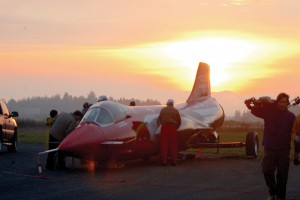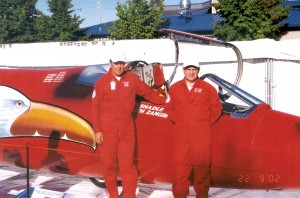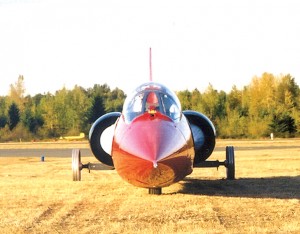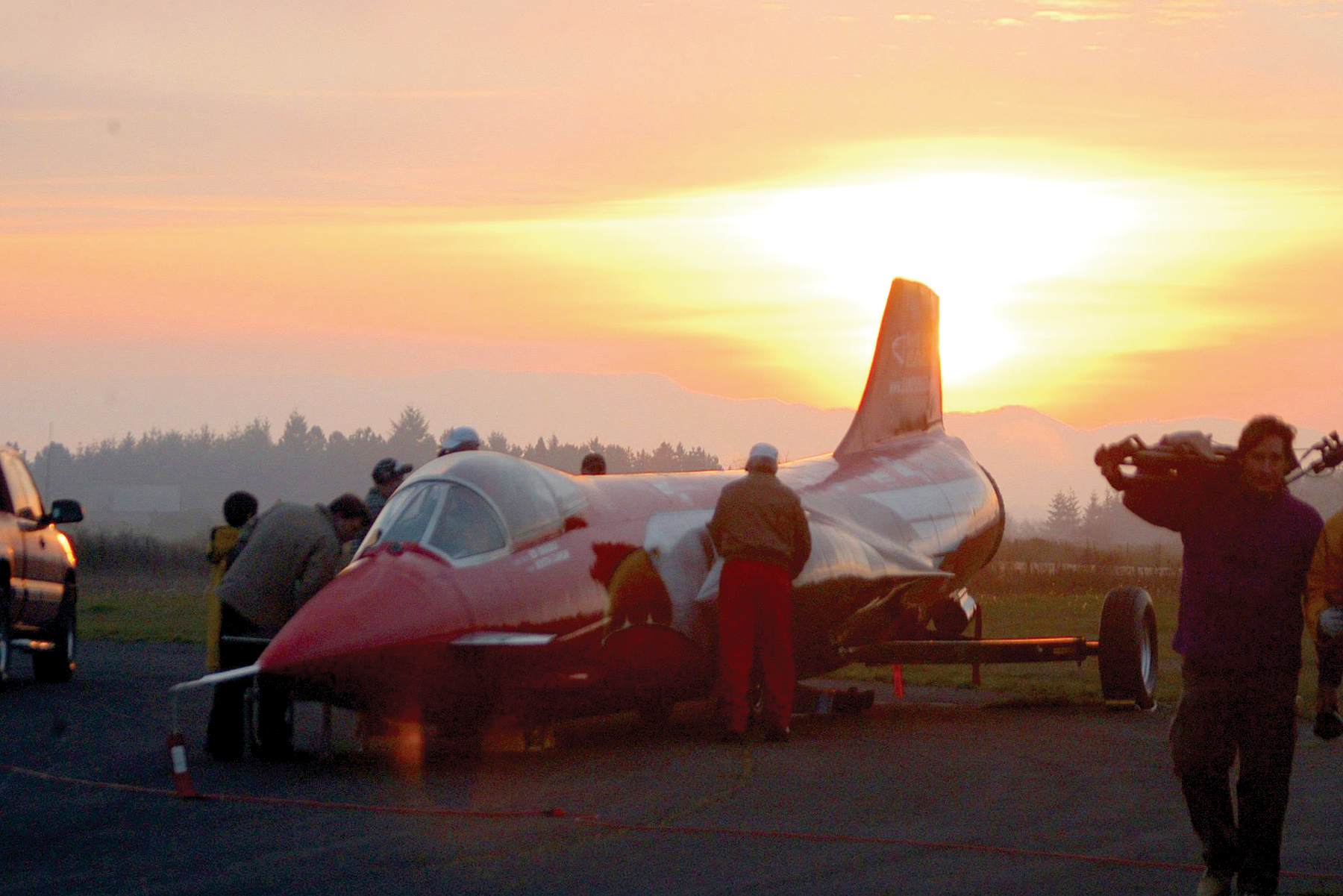By S. Clayton Moore

The North American Eagle made its first test runs in late November of 2004. Although the vehicle experienced some electrical challenges, the team hopes to get it up to 100 percent power before the end of the year.
Call it the ultimate hot rod. A driver straps himself into a vehicle in the middle of Nevada’s Black Rock Desert. Not only is it not your typical motor vehicle, it’s in fact a converted F-104A Starfighter literally rescued from the junkyard. At the stick, the pilot hits the afterburner and the jet shoots forward across the high desert at nearly 800 miles an hour, well past the speed of sound.
That scenario is the goal for the team members of the North American Eagle project, based in Pierce County, Wash., who hope to break the land speed record. For over seven years, a motley crew of Boeing engineers and hot rod mechanics has been working on a vehicle that nearly defies description. Late in 2004, this chopped-up F-104A that was once flown by Chuck Yeager and Scott Crossfield was finally ready for test runs.
It has long been the dream of Ed Shadle, a retired IBM computer technician and Bonneville drag racer, and Keith Zanghi, a supervisor at Boeing’s machine structures shop, to chop this rocket ship into a race car.
“I knew the Starfighter all the way back to my days in the Air Force,” Shadle said. “I knew it was a small and very high-performance aircraft as far as speed. Keith had been looking at a beautiful F-103 in the Smithsonian’s Air and Space Museum at the same time, and we both arrived at the same idea at the same time.”
The idea was to build a North American response to the world land speed record. In October 1997, RAF pilot Andy Green drove his Thrust SSC to a new world record of 763 miles per hour, hitting Mach 1.02 and breaking the sound barrier. That event caused Shadle and Zanghi to abandon an earlier vehicle attempt.
Shadle and Zanghi began by chasing their dream plane at the boneyard at Monthan-Davis AFB in Tucson, only to find the last F-104 had left months before. The pair knew a fully functional plane was out of the question financially, but finally found a gutted shell for $25,000 in Belfast, Maine, a Starfighter with tail number 56-763. The plane’s history included a stint as a chase plane for the X-15 program.
“It was pretty neat when we kept finding out more about the history of this aircraft. I talked with Pete Knight, Bill Dana, Scott Crossfield and Joe Engle at one of the X-15 pilot reunions and they all used to fly 763,” Shadle remembered.
He even managed to connect with a former mechanic at Edwards Air Force Base who remembered 56-763 as one of General Chuck Yeager’s “pet airplanes,” and a sister ship to 56-672, from which Yeager ejected when it crashed in 1963.
Meanwhile, Shadle and a bunch of interested mechanics, engineers and jet jockeys began gathering every Saturday at Shady Acres Airport in Spanaway, Wash. The group includes guys like Bill Eckberg, a Boeing jet engine mechanic, Ed Drumheller, an ejection specialist who worked on NASA’s Gemini program, and John Higley, a schoolteacher with nearly 25 years of experience in Washington public schools. In all, about 30 men and women make up the core group of speed enthusiasts.
“It just starts snowballing and it’s kind of funny how it evolves. These guys just have amazing backgrounds and everybody gets along really well,” Shadle said of Team NAE.
The end result of their efforts is a remarkable combination of aerospace engineering, hot rod mechanics and good old American ingenuity. A 39,000-hp J-79 jet engine originally used in the Phantom F-4 powers the aircraft. This engine has been specially engineered by S&S Turbines of Canada to kick out nearly 20,000 pounds of thrust.
Wings aren’t allowed according to the rules set by the Federation International de L’Automobile, the world governing body for motor sport and land speed records and each vehicle has to have four or more wheels. Team NAE started working on those factors first and ended up developing some fairly radical technology to control heat, speed and lift.

Ed Shadle and Keith Zanghi have been dreaming of using the F-104 Starfighter as a land vehicle for nearly a decade now. They hope to take the North American Eagle to 800 mph.
While the Eagle used F-15 tires for its low-speed test runs, the actual attempt will use forged aluminum wheels and ceramic bearings designed to run at high speeds. Braking is controlled not only with standard air brakes, but also with no-contact magnetic brakes designed by Magnaforce and high-speed parachutes designed by Butler Parachute.
Shadle has been designated as the project’s chief pilot due to his experience as a pilot and with high-speed land racing in his Model T Roadster and dry bed Lakester, both of which have set records in competition.
“Like I told the guys, it all depends on how well I do. If it feels like I’m not the guy that ought to be doing it, I’ll get out of the cockpit and we’ll get some young stud in there,” Shadle said.
Despite the complex technology, the goal is simple and set by the rules of the FAI. To beat Andy Green’s record, Shadle has to run the North American Eagle at least one percent over the old record of 763 mph. Shadle says that once the afterburners are on, the craft does behave more like a plane.
“I use a stick just like an aircraft. That feeds a hydraulic orbital valve and that controls the steering. I also use a throttle so it’s exactly like sitting in the fighter. Everything else just feels like you’re making a hard departure from the local airport in your F-104 Starfighter,” Shadle said.
Discovery Channel Canada will cover this fall’s test runs for a one-hour documentary called “Ultimate Engineering.” The team hopes to run the vehicle through some low-speed taxis up to 100 percent power and if all goes well, fire up the afterburner for a quick run.
“That alone will cover some territory pretty fast,” Shadle said. “It’s been a long time coming. Even when we did our engine tests in June, it was really exciting. We just keep hoping that everything rolls along and we make some progress.”
The media coverage is another area where Shadle has some expertise. He was featured on “The Tonight Show” when he took Jay Leno out for a test run in the Mojave Desert in his previous vehicle and also made an appearance on “Live with Regis and Kathie Lee.”
“We were at the New York Auto Show and ABC asked us to fire up the engines right outside the studio. That was a near disaster. You don’t normally fire up a J-79 in downtown New York City and we won’t do it again,” Shadle laughed.
Although the project has had a lot of exposure, Shadle says they’re still looking for major corporate sponsors. While major companies like Rockwell Aviation, Transaero, and Spencer Aircraft have all donated parts and participation, the team is still looking for logos to put on the wing.
“The biggest challenge is revenue,” Shadle admits. “Keith and I have been funding it out of our pockets with help and support from a lot of people, but just making the rent for the hangar sometimes is a struggle.”
One advantage of the North American Eagle is that because of its hybrid nature, the team can show it off at auto shows as well as aviation venues. The vehicle will certainly be on display at EAA AirVenture Oshkosh and the Reno Air Races in 2005.
Eventually, Team NAE hopes to perform their record-breaking run at Black Rock Desert, where they would have a long, dry lake bed in which to test, somewhat similar to the testing conditions at Edwards Air Force Base.
Shadle and Zanghi’s DIY attitude is part of North American Eagle’s draw.

The North American Eagle has been drastically altered in order to meet the rules for land speed vehicles.
“For some people, it’s amazing that you have a couple of local racers who are doing this on a shoestring,” Shadle said. “We do this in some cases with known, off-the-shelf technology and in some cases we’re building it in the garage and figuring it out ourselves. That’s part of these guys doing their magic.”
Today, thanks to the team’s effort and some donations from interested companies, the North American Eagle carries nearly $1 million in parts.
Working with the team is one of the best things about leading North American Eagle, according to Shadle.
“We have a few PhD’s here and there but most of us are just hot rod mechanics,” Shadle said. “My management style has always been one of delegation and participation. They’re all regular guys; they quip and joke and everybody takes it so well. We’re just a little old team from up here in the Northwest and we’re doing the best we can with what we have.”
For more information, visit [http://www.landspeed.com/].











